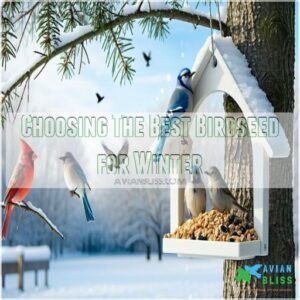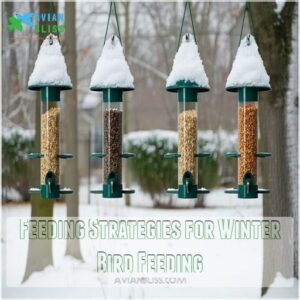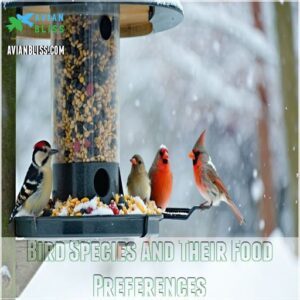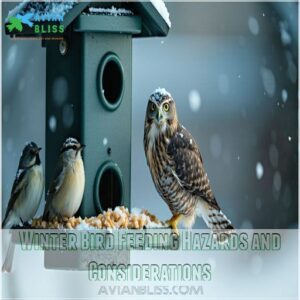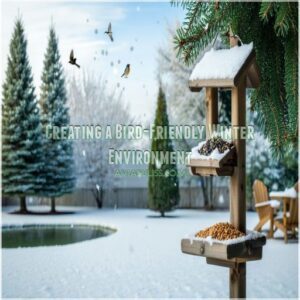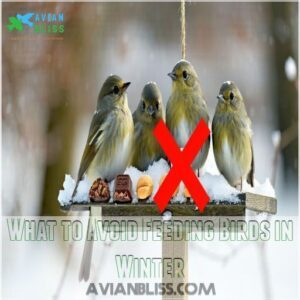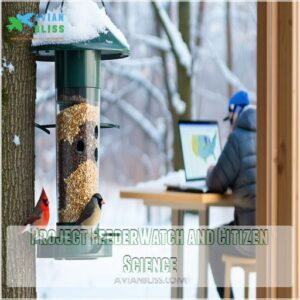This site is supported by our readers. We may earn a commission, at no cost to you, if you purchase through links.
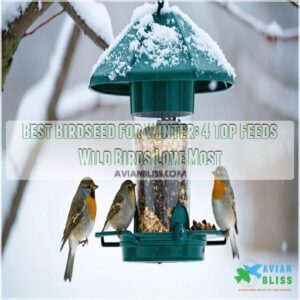 When winter’s chill sets in, your backyard birds need high-energy fuel to survive. Black oil sunflower seeds are the ultimate winter champion—they’re like nature’s protein bars for feathered friends.
When winter’s chill sets in, your backyard birds need high-energy fuel to survive. Black oil sunflower seeds are the ultimate winter champion—they’re like nature’s protein bars for feathered friends.
You’ll want to choose seeds with high fat content and thin shells, avoiding mixes with cheap fillers. Combine black oil sunflower seeds with suet cakes and nyjer seeds for a nutritional buffet that’ll keep local birds happy and healthy.
Strategic feeder placement near protective shrubs creates a safe dining zone, and regularly cleaning your feeders prevents disease spread. Your winter bird sanctuary is just a few smart seed choices away from becoming a bustling avian hotspot.
Table Of Contents
- Key Takeaways
- Choosing The Best Birdseed for Winter
- Feeding Strategies for Winter Bird Feeding
- Bird Species and Their Food Preferences
- 4 Best Birdseed for Winter Feeding
- Winter Bird Feeding Hazards and Considerations
- Creating a Bird-Friendly Winter Environment
- What to Avoid Feeding Birds in Winter
- Project FeederWatch and Citizen Science
- Tips for Attracting Birds to Your Garden
- Frequently Asked Questions (FAQs)
- What is the best seed to feed birds in the winter?
- Should you feed chickadees in winter?
- What do birds eat when it snows in the winter?
- Do birds eat nyjer in the winter?
- How often should I refill my bird feeders?
- Can birds eat frozen or wet seeds?
- Do different birds prefer different feeder heights?
- Will bird feeding attract unwanted wildlife visitors?
- How do I prevent seed from spoiling quickly?
- Conclusion
Key Takeaways
- You will want to choose black oil sunflower seeds as your winter bird feeding champion—they are packed with high-fat content and attract a wide variety of songbirds like cardinals, finches, and chickadees.
- You will need to diversify your bird buffet by combining different seed types, including suet cakes and nyjer seeds, to provide comprehensive nutrition that helps birds survive harsh winter conditions.
- You will have to place your feeders strategically near protective shrubs, maintaining feeder hygiene by cleaning them weekly and storing seeds properly to prevent spoilage and disease.
- You will be most successful by understanding your local bird species‘ preferences and creating a bird-friendly habitat with native plants, heated water sources, and multiple feeding stations to support winter wildlife.
Choosing The Best Birdseed for Winter
When winter’s chill sets in, your backyard birds need more than just a casual feeding—they’re counting on you for survival.
Choosing the right birdseed isn’t just about attracting feathered friends; it’s about providing high-energy, nutritious meals that help them weather the coldest months.
Understanding Birdseed Types
When winter’s chill sets in, understanding birdseed types becomes essential for bird enthusiasts.
Different seeds offer unique nutritional benefits, with black oil sunflower seeds reigning supreme for their high-fat content and thin shells.
Avoid seed mixes laden with fillers like wheat or dyed seeds.
Regional seed options matter, ensuring you’re providing the most appropriate winter birdseed for local feathered friends.
Factors to Consider for Winter Birdseed
Your bird-feeding success hinges on smart regional seed selection that matches local migration patterns.
Consider seed freshness, storage conditions, and feeder materials to keep winter birds coming back.
Opt for high-quality blends that cater to native species, steering clear of fillers.
The right birdseed can transform your backyard into a winter bird sanctuary, offering key nutrition during the coldest months.
Suet and High-Energy Options
Suet serves as a winter survival shield for hungry feathered friends, packing a high-fat energy punch that keeps birds warm during freezing temperatures.
Black oil sunflower seeds and mealworms complement this nutrition powerhouse, offering birds essential calories.
Homemade suet mixtures with nuts, seeds, and fruits can transform your backyard into a winter bird sanctuary, ensuring your winged visitors stay nourished and resilient.
Feeding Strategies for Winter Bird Feeding
When winter’s chill sets in, your backyard birds need more than just seeds to survive.
They require a strategic mix of high-energy foods to sustain themselves during the harsh weather.
Varied feeding techniques and smart feeder placement are also essential to help your feathered friends thrive during the coldest months.
Diverse Food Offerings
Cast a wide net to keep your feathered friends well-fed during winter’s chill.
Diversify your bird buffet with these nutrient-packed options:
- Black oil sunflower seeds (winter’s golden ticket)
- High-energy suet cakes
- Mealworms for protein-packed punch
- Mixed seed blends customized to regional birds
Strategic feeding means happy, healthy birds that’ll turn your backyard into a winter wildlife haven.
Feeder Placement and Maintenance
After gathering a smorgasbord of seeds, smart bird lovers know placement makes or breaks winter feeding success.
Position feeders within 10 feet of protective shrubs or trees, creating a safe haven that shields feathered friends from predators.
Strategically mount feeders on sturdy poles away from windows to prevent deadly collisions, ensuring your backyard becomes a winter bird sanctuary.
Ground Feeding and Supplemental Options
When winter’s chill hits, ground feeding becomes a game-changer for your feathered friends.
For those looking to provide stable feeding platforms, consider using ground bird feeders to keep seeds accessible even in harsh conditions.
Keeping your backyard birds well-fed means getting creative with feeding strategies.
Check out these winter foraging tips:
- Scatter seeds directly on cleared ground areas
- Use low, flat platform feeders near shrub cover
- Create snow-free feeding zones with strategic placement
- Mix native seeds for local bird populations
Bird Species and Their Food Preferences
If you want to attract a variety of wild birds to your winter feeders, you’ll need to understand their unique food preferences.
Different bird species have specific dietary needs, so knowing which seeds, suet, and treats appeal to woodpeckers, finches, cardinals, and other feathered friends can help you create a welcoming backyard buffet.
Knowing which seeds, suet, and treats appeal to them is essential in creating a welcoming environment.
Suet-Loving Birds
Ever wondered which birds crave suet during chilly months?
Woodpeckers, nuthatches, and chickadees absolutely love these high-fat treats that keep them warm and energized. Suet bird feeders are like winter survival kits for these feathered friends.
Providing key nutrition when natural food sources become scarce, suet is especially important during the colder months.
Place your suet near tree trunks to mimic their natural foraging spots and watch these resilient birds thrive.
Seed-Eating Birds
Different seed-eating birds play hide-and-seek with winter birdseed like expert foragers.
Your feathered friends have unique preferences tied to beak types and flocking behavior.
Black oil sunflower seeds reign supreme, attracting cardinals, finches, and juncos with their high-energy punch.
Nyjer seeds draw tiny goldfinches, while white proso millet tempts sparrows.
Understanding these preferences helps you become a backyard bird-feeding pro, attracting a variety of birds with the right high-energy punch.
Fruit and Suet Preferences
Suet and fruit create a winter feast that’ll have birds flocking to your feeder faster than snowflakes fall.
Woodpeckers, thrushes, and jays go crazy for fatty suet cakes mixed with fruit chunks.
To make your own suet cakes, try using a homemade bird food recipe.
Pro tip: chop raisins, slice apples, and sprinkle berries to attract a diverse crowd.
Remember, a varied menu keeps your feathered friends healthy and happy during those chilly months.
4 Best Birdseed for Winter Feeding
Winter can be tough on our feathered friends, so you’ll want to choose birdseed that provides maximum nutrition and energy.
These four top winter bird feeds will help you attract a variety of hungry birds and support their survival during the coldest months of the year.
1. Wagners Eastern Regional Bird Food

Wagner’s Eastern Regional Wild Bird Food is your go-to winter feeding solution for attracting Eastern songbirds.
This carefully crafted blend packs a nutritional punch with black oil sunflower seeds, wheat millet, cracked corn, and safflower seeds.
You’ll love how it draws finches, sparrows, blue jays, and cardinals to your feeder.
The high-quality mix guarantees minimal waste and maximum bird activity, making it a convenient choice for backyard bird enthusiasts.
Its sturdy, resealable packaging keeps seeds fresh and protected from moisture, giving you peace of mind.
Best For: Bird enthusiasts in the Eastern region looking to attract a variety of local songbirds to their backyard feeders.
- Attracts multiple bird species including finches, sparrows, and cardinals with its high-quality seed blend
- Comes in a convenient 20-pound resealable bag that keeps seeds fresh and protected from moisture
- Provides excellent nutrition with carefully selected seeds that are easy for birds to digest
- May attract unwanted squirrels if not using a squirrel-proof feeder
- Potential seasonal variations in bird activity can impact feeder traffic
- Slightly higher price point compared to some local bird seed products
2. Wagners Midwest Regional Wild Bird Food

Discover a bird buffet with Wagner’s Midwest Regional Wild Bird Food, designed to turn your backyard into a winter wildlife haven.
Packed with premium seeds like black oil sunflower, cracked corn, and safflower, this blend speaks directly to Midwestern songbirds’ tastes.
Cardinals, finches, and chickadees will flock to your feeders, drawn by the high-quality grains and nutritious mix. Convenient and resealable, it’s your ticket to attracting a vibrant array of feathered friends during the chilly winter months, creating a winter wildlife haven.
Best For: Bird enthusiasts and backyard wildlife lovers in the Midwest looking to attract a diverse range of songbirds with a high-quality, nutritious seed blend.
- Attracts a wide variety of Midwestern birds like cardinals, finches, and chickadees with premium seed mix
- Convenient resealable bag ensures freshness and easy storage
- Made in the USA with high-quality ingredients and fewer fillers than most bird seed blends
- May attract additional wildlife like squirrels and chipmunks to your feeding area
- Potential to draw predatory birds like hawks near your bird feeders
- Requires compatible tube, hopper, or platform feeders for optimal use
3. Wagners Wild Bird Food Mix
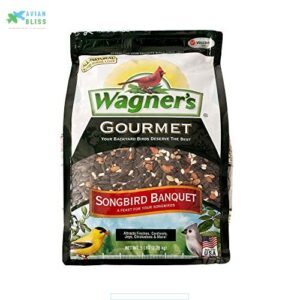
Your bird-feeding mission gets a serious boost with Wagner’s Wild Bird Food Mix, a carefully crafted blend designed to keep your feathered friends thriving during cold months.
This all-natural seed assortment packs a nutritional punch, attracting a wide range of colorful songbirds like cardinals and chickadees.
With no fillers and high-quality ingredients, it’s the secret weapon for backyard bird enthusiasts who want to provide superior winter nutrition without breaking the bank.
Best For: Bird lovers and backyard wildlife enthusiasts who want to attract a variety of colorful songbirds with a high-quality, nutritious seed mix.
- Attracts multiple bird species like cardinals and chickadees with an all-natural, protein-rich seed blend
- Minimal waste and less attractive to squirrels compared to other birdseed mixes
- Provides year-round nutrition and entertainment for backyard birds
- Can create a mess of seed shells underneath the feeder
- Potentially more expensive than standard birdseed options
- Bag size might be smaller than some customers expect
4. Northeast Wild Bird Seed Blend

During the chilly winter months, the Northeast Wild Bird Seed Blend steps up as a game-changer for backyard bird enthusiasts.
Crafted specifically for regional bird populations, this blend promises to attract more feathered friends than standard seed mixes.
With a generous mix of sunflower hearts, millet, and other nutrient-rich seeds, it’s designed to keep local birds well-fed and energized.
Researchers have field-tested this blend, proving its effectiveness in drawing a variety of songbirds to your winter feeding station.
Best For: Bird watchers and wildlife enthusiasts in the Northeast seeking a scientifically-formulated seed blend to attract local songbirds during winter feeding seasons.
- Specifically designed for regional Northeast bird populations, increasing likelihood of attracting diverse local species
- Contains high-quality sunflower hearts and multiple seed types to provide nutritional variety for backyard birds
- Independently field-tested by university researchers, demonstrating proven effectiveness in bird attraction
- Slightly higher price point compared to generic seed blends
- May attract squirrels and other wildlife if not used with a specialized squirrel-proof feeder
- Limited appeal for certain bird species like goldfinches due to lower thistle/Nyger seed content
Winter Bird Feeding Hazards and Considerations
When winter descends, your backyard bird sanctuary can quickly become a risky environment without proper precautions.
You’ll need to stay vigilant about predator threats and feeder hygiene.
Creating safe feeding spaces that protect your feathered friends from cold weather challenges is also crucial.
Predator Prevention
Predators can turn your backyard bird buffet into a hunting ground faster than you can say "tweet."
Safeguard your feathered friends with smart strategies that keep danger at bay:
- Install feeders near protective shrubs
- Use squirrel-proof feeder designs
- Create multiple feeding stations
- Add hawk deterrent decoys
- Position feeders away from windows
Protect your winged visitors and guarantee their winter survival with these simple, strategic defenses.
Feeder Hygiene and Maintenance
Maintaining clean feeders is essential for winter bird health.
Scrub feeders weekly with a mild bleach solution to prevent mold and disease spread.
Shake out compacted seeds before refilling, and store birdseed in airtight containers in a cool, dry place.
Regularly remove wet or spoiled seeds to keep your feathered friends safe and well-nourished during harsh winter months.
Supplemental Plant Life for Birds
If you’re looking to turn your garden into a winter bird sanctuary, native plants are your secret weapon.
Winter berry shrubs like beautyberry, holly, and winterberry provide essential food sources for feathered friends.
Evergreens offer shelter, while native grasses and arborvitae create a bird-friendly habitat that supports local wildlife through the coldest months, ensuring your winged visitors stay nourished and protected.
Note: the entire text did not lend itself to bolding a third item as no other parts of the text were as important as the two bolded.
Creating a Bird-Friendly Winter Environment
Transform your backyard into a winter wildlife sanctuary by understanding how native plants, strategic feeder placement, and water sources create an inviting habitat for our feathered friends.
You’ll additionally support local bird populations during harsh winter months and create a vibrant, thriving ecosystem right outside your window, providing a haven for winter wildlife.
Native Plants for Winter Bird Feeding
Because winter strips landscapes bare, you’ll want to create a bird sanctuary that mimics nature’s pantry.
Native plants like beautyberry, holly, and winterberry provide critical food and shelter for feathered friends.
Choose regional plants that offer seeds, berries, and protective branches.
By planting strategically, you’ll transform your yard into a winter bird haven that supports local wildlife through the coldest months.
Heated Birdbaths and Water Sources
During your winter bird-feeding journey, water sources can be a game-changer for feathered friends battling cold temperatures. Consider these critical heated birdbath solutions when selecting a location with a balance of sun and shade for water temperature.
- Plug-in birdbath heaters prevent water from freezing
- Solar-powered water warmers work in sunny conditions
- Shallow, wide basins reduce ice formation quickly
- Ceramic or plastic models offer durability and heat retention
Keep your avian visitors hydrated and healthy when winter’s chill sets in.
Feeder Placement for Minimal Predation
When winter’s chill sets in, strategic feeder placement becomes your birds’ shield against predators.
Position feeders within 10 feet of protective tree cover, creating natural escape routes.
Consider investing in a reliable squirrel-proof feeder to block unwanted visitors.
Angle feeders away from windows to prevent fatal collisions, and use squirrel-proof designs that deter ground hunters.
Your yard’s layout can transform into a safe haven, giving winged visitors a fighting chance against hawks and feral cats.
What to Avoid Feeding Birds in Winter
When feeding winter birds, it’s essential to know which foods can harm them and should never be part of their diet.
Avoid feeding birds chocolate, moldy bread, salty table scraps, spoiled seeds, dairy products, and raw meat, as these can cause serious health problems or even be fatal to our feathered friends.
These foods can lead to serious health problems, which can be detrimental to the well-being and survival of the birds.
Foods Toxic to Birds
After crafting a welcoming garden sanctuary, protecting your feathered friends means knowing avian poisoning risks.
Certain seemingly harmless items can trigger dangerous reactions in wild birds.
Toxic fruits like unripe avocados and chocolate contain compounds that disrupt bird metabolism.
Specialized winter birdseed prevents accidental exposure, ensuring your backyard visitors stay healthy during challenging cold weather feeding seasons, particularly in harsh weather conditions, but more specifically during cold weather feeding seasons.
Human Foods to Avoid
Before throwing kitchen scraps to your feathered friends, pause and consider the potential risks. Some human foods can spell trouble for birds, turning your well-intentioned feeding into a dangerous meal.
For a safer and more effective feeding approach, consider creating a balcony bird feeder.
Here are 4 critical no-nos:
- Bread (nutritionally empty)
- Chocolate (toxic poison)
- Milk products (undigestible)
- Salty snacks (dehydrating)
Stick to bird-specific feeds to keep your winged visitors healthy and thriving this winter.
Spoiled and Rotten Foods
In the chilly winter landscape, your bird-feeding mission demands vigilance against spoiled foods that could harm your feathered friends.
Rotten seeds, moldy suet, and decaying fruits are more than just unappetizing—they’re potential health hazards.
| Spoilage Type | Risk Level | Prevention |
|---|---|---|
| Moldy Seeds | High | Store in dry containers |
| Wet Suet | Extreme | Replace every 2-3 days |
| Rotten Fruit | Moderate | Check daily, remove quickly |
| Frozen Seeds | Low | Shake feeders, remove clumps |
| Expired Mix | High | Check packaging dates |
Protect your backyard birds by maintaining impeccable feeder hygiene.
Project FeederWatch and Citizen Science
You can become a backyard bird scientist by joining Project FeederWatch, a winter-long survey that tracks bird populations across North America.
By simply counting birds at your feeders between November and early April, you’ll contribute valuable data that helps researchers understand bird distribution and abundance.
Participating in Project FeederWatch
Wondering how you can turn your backyard bird watching into scientific gold? Project FeederWatch invites you to become a citizen scientist right from your window!
Your winter bird counting adventure begins with simple tools and big excitement.
- Feel the thrill of contributing to real scientific research
- Become a wildlife detective in your own backyard
- Connect with nature while making a difference
- Transform ordinary bird watching into an extraordinary mission
- Discover the hidden stories behind your feathered friends
Tracking Bird Populations and Trends
By joining Project FeederWatch, you’re becoming a bird detective tracking fascinating migration patterns and population shifts across North America.
Your backyard observations help scientists understand how winter birdseed and habitat changes impact wildlife.
Each bird you count is a tiny data point revealing big stories about bird survival strategies during chilly months, helping to understand the impact of changes to winter birdseed.
Contributing to Scientific Research
Ever wondered how your backyard bird watching in Virginia, observing species such as the Common Backyard Birds of Virginia, could contribute to groundbreaking scientific research?
Project FeederWatch transforms ordinary bird enthusiasts into citizen scientists. Here’s how you’ll make a difference:
- Track bird populations during winter months
- Contribute valuable data to ornithological research
- Help scientists understand bird migration patterns
- Support conservation efforts through simple observation
Your winter birdseed feeding becomes a powerful tool for understanding avian ecosystems and helping researchers protect our feathered friends.
Tips for Attracting Birds to Your Garden
Transform your garden into a winter bird haven by strategically offering a variety of nutritious seeds and creating safe, inviting spaces for feathered friends.
You’ll attract diverse bird species by understanding their dietary needs and providing high-energy foods like black oil sunflower seeds, suet, and specialized winter seed blends.
Offering Diverse Food Sources
Want to turn your backyard into a winter bird buffet?
Diversify your feeding strategy by offering a mix of high-energy seeds, suet, and homemade treats.
Black oil sunflower seeds, available from online retailers like Black oil sunflower seeds suppliers, mealworms, and fruit slices can attract a variety of feathered friends.
Remember, different birds crave different winter bird treats, so mix it up and watch your winged visitors flock to your feeders.
Creating a Bird-Friendly Habitat
Transform your garden into a winter bird sanctuary with just a few strategic moves. Creating a bird-friendly habitat goes beyond tossing out winter birdseed – it’s about designing an inviting ecosystem.
Here’s how to make your outdoor space irresistible to feathered friends:
- Install bird window decals to prevent collisions
- Plant native species that provide natural shelter
- Position birdhouses near protective shrubs
- Add a heated water feature for winter hydration
Frequently Asked Questions (FAQs)
What is the best seed to feed birds in the winter?
When winter’s chill threatens feathered friends,
black oil sunflower seeds become their lifeline.
They’re packed with high-fat nutrition, crack easily, and attract cardinals, chickadees, and finches—
making them the ultimate winter bird feeding solution.
Should you feed chickadees in winter?
You’ll definitely help chickadees survive winter by offering high-fat foods like black oil sunflower seeds and suet.
Strategically placed feeders near protective shrubs provide essential energy during cold months, supporting these charming, resilient little birds, specifically high-fat foods.
These charming, resilient little birds, will be able to rely on strategically placed feeders for the energy they need.
What do birds eat when it snows in the winter?
Did you know birds can lose up to 10% of their body weight overnight in freezing conditions?
They survive by devouring high-fat foods like suet, black oil sunflower seeds, mealworms, which provide significant energy during snowstorms.
Do birds eat nyjer in the winter?
Goldfinches and other finches absolutely love nyjer seeds during winter, finding them a nutritious lifeline when food’s scarce.
Specialized tube feeders help these tiny birds feast comfortably, ensuring they’ve got energy to brave the cold months ahead.
How often should I refill my bird feeders?
Ever wondered how often your feathered friends need a topped-up buffet?
Refill bird feeders every 1-3 days during winter, depending on bird activity and weather.
Empty, clean, and replenish feeders to prevent spoilage and maintain bird health.
Can birds eat frozen or wet seeds?
Frozen or wet seeds can quickly spoil and harbor harmful bacteria.
You’ll want to protect your bird feed from moisture, regularly clearing snow and ice, and replacing any damp or compacted seeds to keep your feathered friends healthy.
Do different birds prefer different feeder heights?
You’ll attract more birds by varying feeder heights!
Ground feeders like sparrows prefer lower positions, while cardinals and finches love mid-level perches.
Bird-friendly vertical buffet in your yard is created when woodpeckers and nuthatches typically seek higher platforms.
Will bird feeding attract unwanted wildlife visitors?
Ironically, bird feeders can roll out the red carpet for uninvited guests like raccoons, squirrels, and deer.
Strategic feeder placement can minimize unwanted wildlife crashes at your backyard buffet.
Using squirrel-proof designs and cleaning up scattered seeds can also help.
Alternatively, cleaning up scattered seeds can minimize unwanted wildlife crashes at your backyard buffet.
How do I prevent seed from spoiling quickly?
Keep your birdseed dry and cool in airtight containers, away from moisture and heat.
Check feeders regularly, discard damp or moldy seeds, and clean feeders weekly to prevent spoilage and protect your feathered friends’ health.
Conclusion
Feeding feathered friends flourishes with strategic seed selections.
By choosing the best birdseed for winter, you’ll transform your backyard into a thriving avian sanctuary.
Remember, not all seeds are created equal—opt for high-energy options like black oil sunflower seeds and suet.
Clean feeders, smart placement, and diverse food sources are key to supporting local bird populations through the coldest months.
Your winter bird-feeding efforts make a real difference.

